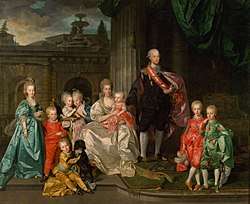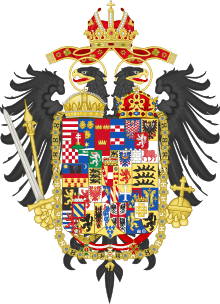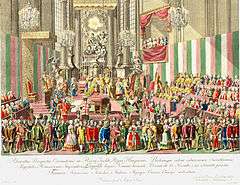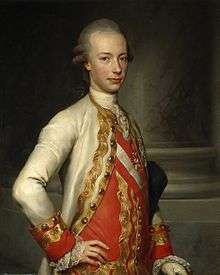Leopold II, Holy Roman Emperor
Leopold II (Peter Leopold Joseph Anton Joachim Pius Gotthard; 5 May 1747 – 1 March 1792) was Holy Roman Emperor, King of Hungary and Bohemia, and Archduke of Austria from 1790 to 1792, and Grand Duke of Tuscany from 1765 to 1790.[1] He was the earliest opponent of capital punishment in modern history. He was a son of Empress Maria Theresa and her husband, Emperor Francis I, and the brother of Marie Antoinette, Queen of France, Maria Carolina of Austria and Joseph II, Holy Roman Emperor. Leopold was a moderate proponent of enlightened absolutism.[2] He granted the Academy of Georgofili his protection. Despite his brief reign, he is highly regarded. The historian Paul W. Schroeder called him "one of the most shrewd and sensible monarchs ever to wear a crown".[3]
Youth

Leopold was born in Vienna as his parents' third son. Initially selected for a clerical career he received education with focus on theology. In 1753, he was engaged to Maria Beatrice d'Este, heiress to the Duchy of Modena.
The marriage was never consummated and Maria Beatrice instead married Leopold's brother, Archduke Ferdinand.[4]
Upon the early death of his older brother Archduke Charles in 1761, the family decided that Leopold was going to succeed his father as Duke of Tuscany. Tuscany had been envisioned and designated as a Secundogeniture, a territory and title bestowed upon the second born son, which was greater than an Appanage. On 5 August 1764 Leopold married the Infanta Maria Luisa of Spain, daughter of Charles III of Spain and Maria Amalia of Saxony. Upon the death of his father, Francis I on 18 August 1765, he became Duke of Tuscany.
Grand Duke of Tuscany

For five years, Leopold exercised little more than nominal authority, under the supervision of counselors appointed by his mother. In 1770, he made a journey to Vienna to secure the removal of this vexatious guardianship and returned to Florence with a free hand. During the twenty years that elapsed between his return to Florence and the death of his eldest brother Joseph II in 1790, he was employed in reforming the administration of his small state. The reformation was carried out by the removal of the ruinous restrictions on industry and personal freedom imposed by his predecessors of the house of Medici and left untouched during his father's life, by the introduction of a rational system of taxation (reducing the rates of taxation), and by the execution of profitable public works, such as the drainage of the Val di Chiana.[5]
As Leopold had no army to maintain, and as he suppressed the small naval force kept up by the Medici, the whole of his revenue was left free for the improvement of his state. Leopold was never popular with his Italian subjects. His disposition was cold and retiring. His habits were simple to the verge of sordidness, though he could display splendour on occasion, and he could not help offending those of his subjects who had profited by the abuses of the Medicean régime.[6]
But his steady, consistent, and intelligent administration, which advanced step by step, brought the grand duchy to a high level of material prosperity. His ecclesiastical policy, which disturbed the deeply rooted convictions of his people and brought him into collision with the Pope, was not successful. He was unable to secularize the property of the religious houses or to put the clergy entirely under the control of the lay power. However, his abolition of capital punishment was the first permanent abolition in modern times. On 30 November 1786, after having de facto blocked capital executions (the last was in 1769), Leopold promulgated the reform of the penal code that abolished the death penalty and ordered the destruction of all the instruments for capital execution in his land. Torture was also banned.[7][8]
In line with the theories of the Age of Enlightenment, he enlarged La Specola with medical waxworks and other exhibits, aiming to educate Florentines in the empirical observation of natural laws.[9]
Leopold also approved and collaborated on the development of a political constitution, said to have anticipated by many years the promulgation of the French constitution and which presented some similarities with the Virginia Bill of Rights of 1778. Leopold's concept of this was based on respect for the political rights of citizens and on a harmony of power between the executive and the legislative. However, it could not be put into effect because Leopold moved to Vienna to become emperor in 1790, and because it was so radically new that it garnered opposition even from those who might have benefited from it.[10]

Leopold developed and supported many social and economic reforms. Smallpox inoculation was made systematically available, and an early institution for the rehabilitation of juvenile delinquents was founded. Leopold also introduced radical reforms to the system of neglect and inhumane treatment of those deemed mentally ill. On 23 January 1774, the "legge sui pazzi" (law on the insane) was established, the first of its kind to be introduced in all Europe, allowing steps to be taken to hospitalize individuals deemed insane. A few years later Leopold undertook the project of building a new hospital, the Bonifacio Hospital. He used his skill at choosing collaborators to put a young physician, Vincenzo Chiarugi, at its head. Chiarugi and his collaborators introduced new humanitarian regulations in the running of the hospital and caring for the mentally ill patients, including banning the use of chains and physical punishment, and in so doing have been recognized as early pioneers of what later came to be known as the moral treatment movement.[10]
During the last few years of his rule in Tuscany, Leopold had begun to be frightened by the increasing disorders in the German and Hungarian dominions of his family, which were the direct result of his brother's strict methods. He and Joseph II were tenderly attached to one another and met frequently both before and after the death of their mother. The portrait by Pompeo Batoni in which they appear together shows that they bore a strong personal resemblance to one another. But it may be said of Leopold, as of Fontenelle, that his heart was made of brains. He knew that he had to succeed his childless eldest brother in Austria, and he was unwilling to inherit his unpopularity. When, therefore, in 1789 Joseph, who knew himself to be dying, asked him to come to Vienna and become co-regent, Leopold evaded the request.
He was still in Florence when Joseph II died at Vienna on 20 February 1790, and he did not leave his Italian capital until 3 March 1790. Following the principal of secundogeniture which had allowed him to rule Tuscany, Leopold entrusted the Grand Duchy to his younger son Ferdinand III, who ruled until the French invasion in 1797 and then again from 1814 to 1824.
Holy Roman Emperor






Leopold, during his government in Tuscany, had shown a speculative tendency to grant his subjects a constitution. When he succeeded to the Austrian lands, he began by making large concessions to the interests offended by his brother's innovations. He recognized the Estates of his different dominions as "the pillars of the monarchy", pacified the Hungarians and Bohemians, and divided the insurgents in the Austrian Netherlands (now Belgium) by means of concessions. When these failed to restore order, he marched troops into the country and re-established his own authority, and at the same time the historic franchises of the Flemings. Yet he did not surrender any part that could be retained of what Maria Theresa and Joseph had done to strengthen the hands of the state. He continued, for instance, to insist that no papal bull could be published in his dominions without his consent (placetum regium). One of the harshest actions Leopold took to placate the noble communities of the various Habsburg domains was to issue a decree on 9 May 1790, that forced thousands of Bohemian serfs freed by his brother Joseph back into servitude.
Leopold lived for barely two years after his accession as Holy Roman Emperor, and during that period he was hard pressed by peril from west and east alike. The growing revolutionary disorders in France endangered the life of his sister Marie Antoinette, the queen of Louis XVI, and also threatened his own dominions with the spread of subversive agitation. His sister sent him passionate appeals for help, and he was pestered by the royalist émigrés, who were intriguing to bring about armed intervention in France.
From the east he was threatened by the aggressive ambition of Catherine II of Russia and by the unscrupulous policy of Prussia. Catherine would have been delighted to see Austria and Prussia embark on a crusade in the cause of kings against the French Revolution. While they were busy beyond the Rhine, she would have annexed what remained of Poland and made conquests against the Ottoman Empire. Leopold II had no difficulty in seeing through the rather transparent cunning of the Russian empress, and he refused to be misled.
To his sister, he gave good advice and promises of help if she and her husband could escape from Paris. The émigrés who followed him pertinaciously were refused audience, or when they forced themselves on him, were peremptorily denied all help. Leopold was too purely a politician not to be secretly pleased at the destruction of the power of France and of her influence in Europe by her internal disorders. Within six weeks of his accession, he displayed his contempt for France's weakness by practically tearing up the treaty of alliance made by Maria Theresa in 1756 and opening negotiations with Great Britain to impose a check on Russia and Prussia.
Leopold put pressure on Great Britain by threatening to cede his part of the Low Countries to France. Then, when sure of British support, he was in a position to baffle the intrigues of Prussia. A personal appeal to Frederick William II led to a conference between them at Reichenbach in July 1790, and to an arrangement which was in fact a defeat for Prussia: Leopold's coronation as king of Hungary on 11 November 1790, preceded by a settlement with the Diet in which he recognized the dominant position of the Magyars. He had already made an eight months' truce with the Turks in September, which prepared the way for the termination of the war begun by Joseph II. The pacification of his eastern dominions left Leopold free to re-establish order in Belgium and to confirm friendly relations with Britain and the Netherlands.
During 1791, the emperor remained increasingly preoccupied with the affairs of France. In January, he had to dismiss the Count of Artois (afterwards Charles X of France) in a very peremptory way. His good sense was revolted by the folly of the French émigrés, and he did his utmost to avoid being entangled in the affairs of that country. The insults inflicted on Louis XVI and Marie Antoinette, however, at the time of their attempted flight to Varennes in June, stirred his indignation, and he made a general appeal in the Padua Circular to the sovereigns of Europe to take common measures in view of events which "immediately compromised the honour of all sovereigns, and the security of all governments." Yet he was most directly interested in negotiations with Turkey, which in June led to a final peace, the Treaty of Sistova being signed in August 1791.
On 25 August 1791, he met the king of Prussia at Pillnitz Castle, near Dresden, and they drew up the Declaration of Pillnitz, stating their readiness to intervene in France if and when their assistance was called for by the other powers. The declaration was a mere formality, for, as Leopold knew, neither Russia nor Britain was prepared to act, and he endeavored to guard against the use which he foresaw the émigrés would try to make of it. In face of the reaction in France to the Declaration of Pillnitz, the intrigues of the émigrés, and attacks made by the French revolutionists on the rights of the German princes in Alsace, Leopold continued to hope that intervention might not be required. When Louis XVI swore to observe the constitution of September 1791, the emperor professed to think that a settlement had been reached in France. The attacks on the rights of the German princes on the left bank of the Rhine, and the increasing violence of the parties in Paris which were agitating to bring about war, soon showed, however, that this hope was vain. Leopold meant to meet the challenge of the revolutionists in France with dignity and temper, however the effect of the Declaration of Pillnitz was to contribute to the radicalization of their political movement.
Leopold died suddenly in Vienna, in March 1792, although some said he was poisoned or secretly murdered.[11]
Like his parents before him, Leopold had sixteen children, the eldest of his eight sons being his successor, Emperor Francis II. Some of his other sons were prominent personages in their day. Among them were: Ferdinand III, Grand Duke of Tuscany; Archduke Charles, Duke of Teschen, a celebrated soldier; Archduke Johann of Austria, also a soldier; Archduke Joseph, Palatine of Hungary; and Archduke Rainer, Viceroy of Lombardy-Venetia.
Mozart's opera La clemenza di Tito was commissioned by the Estates of Bohemia for the festivities that accompanied Leopold's coronation as king of Bohemia in Prague on 6 September 1791.[12] Joseph František Maximilian, 7th Prince Lobkowicz, commissioned a reconstruction of the Lobkowicz Palace's exterior in honor of the coronation, giving the palace the appearance that it retains to this day.
Titles and styles
His Imperial Majesty Leopold II, By the Grace of God, Holy Roman Emperor; King of Germany, Hungary, Bohemia, Dalmatia, Croatia, Slavonia, Galicia and Lodomeria, Rama, Serbia, Cumania and Bulgaria; Archduke of Austria; Duke of Burgundy, Lorraine, Styria, Carinthia, Carniola, Grand Duke of Etruria; Grand Prince of Transylvania; Margrave of Moravia, Prince of Brabant, Limburg, Luxembourg, Geldern, Württemberg, Upper and Lower Silesia, Milan, Mantua, Parma, Piacenza, Guastalla, Auschwitz and Zatoria, Calabria, Bar, Ferrete and Teschen; Lord of Svevia and Charleville; Count of Habsburg, Flanders, Hannonia, Kyburg, Gorizia, Gradisca; Margrave of Burgau, Upper and Lower Lusatia, Pont-a-Mousson and Nomenum, Count of Provinces of Namur, Valdemons, Albimons, Count of Zütphen, Sarverda, Salma and Falkenstein, Lord of the Wend Margravate and Mechelen, etc.[13]
Issue
His mother Empress Maria Theresa was the last Habsburg, and he was one of 16 children. His brother Joseph II died without any surviving children, but Leopold in turn had also 16 children just like his mother, and became the founder of the main line of the House of Habsburg-Lorraine. Children with his wife Infanta Maria Luisa of Spain (also known as Maria Ludovica of Spain):
| Name | Birth | Death | Notes |
|---|---|---|---|
| Archduchess Maria Theresa | 14 January 1767 | 7 November 1827 (aged 60) | Married Anton I of Saxony in 1787; no surviving issue. |
| Franz II, Holy Roman Emperor | 12 February 1768 | 2 March 1835 (aged 67) | Married (1) Duchess Elisabeth of Württemberg in 1788; no surviving issue. Married (2) Princess Maria Teresa of Naples and Sicily in 1790; had issue. Married (3) Archduchess Maria Ludovika of Austria-Este in 1808; no issue. Married (4) Caroline Augusta of Bavaria in 1816; no issue. Franz II would be the last Holy Roman Emperor. |
| Ferdinand III, Grand Duke of Tuscany | 6 May 1769 | 18 June 1824 (aged 55) | Married (1) Princess Luisa of Naples and Sicily in 1790; had issue. Married (2) Princess Maria Ferdinanda of Saxony daughter of Maximilian, Crown Prince of Saxony in 1821; no issue. |
| Archduchess Maria Anna | 22 April 1770 | 1 October 1809 (aged 39) | Never married. Became an Abbess at the Theresian Convent in Prague. |
| Archduke Charles | 5 September 1771 | 30 April 1847 (aged 75) | Married Henrietta of Nassau-Weilburg in 1815; had issue. |
| Archduke Alexander Leopold | 14 August 1772 | 12 July 1795 (aged 22) | Never married. Accidentally burned to death from a mishap fireworks show. |
| Archduke Albrecht Johann Joseph | 19 September 1773 | 22 July 1774 (aged 8 months) | Died in infancy. |
| Archduke Maximilian Johann Joseph | 23 December 1774 | 10 March 1778 (aged 3) | Died in infancy. |
| Archduke Joseph | 9 March 1776 | 13 January 1847 (aged 70) | Married (1) Grand Duchess Alexandra Pavlovna of Russia in 1799; no surviving issue. Married (2) Princess Hermine of Anhalt-Bernburg-Schaumburg-Hoym in 1815; had issue. Married Duchess Maria Dorothea of Württemberg in 1819; had issue. He and his eldest son were the last two Counts palatine of Hungary. |
| Archduchess Maria Clementina | 24 April 1777 | 15 November 1801 (aged 24) | Married the Hereditary Prince of Naples, the later king Francis I of the Two Sicilies in 1797; her only surviving issue, daughter Caroline became the Duchess of Berry, and mother of the pretender Henri, Count of Chambord as well as Louise, mother of Robert, Duke of Parma. |
| Archduke Anton | 31 August 1779 | 2 April 1835 (aged 55) | Never married; became Grand Master of Teutonic Knights. |
| Archduchess Maria Amalia | 17 October 1780 | 25 December 1798 (aged 18) | Never married. |
| Archduke John | 20 January 1782 | 11 May 1859 (aged 77) | Married morganatically to Countess Anna Plochl in 1829 and had issue. The counts of Meran descend from him. |
| Archduke Rainer | 30 September 1783 | 16 January 1853 (aged 69) | Married Princess Elisabeth of Savoy-Carignan, sister of king Charles Albert of Sardinia in 1820; had issue. |
| Archduke Louis | 13 December 1784 | 21 December 1864 (aged 80) | Never married. |
| Archduke Rudolph | 8 January 1788 | 24 July 1831 (aged 43) | Never married. Became Archbishop of Olmütz created Cardinal on 4 June 1819. |
Ancestors
| Ancestors of Leopold II, Holy Roman Emperor[14] | |||||||||||||||||||||||||||||||||||||||||||||||||||||||||||||||||||||||||||||||||||||||||||||||||||||||||||||||||||||||||||||||||||||||||||||||||||||||||||||||||||||||||||||||||||||||||||||||||||||||||||||||||||||||||||||||||||||||||||||||||||||||||||||||||||||||||||||||||||||||||
|---|---|---|---|---|---|---|---|---|---|---|---|---|---|---|---|---|---|---|---|---|---|---|---|---|---|---|---|---|---|---|---|---|---|---|---|---|---|---|---|---|---|---|---|---|---|---|---|---|---|---|---|---|---|---|---|---|---|---|---|---|---|---|---|---|---|---|---|---|---|---|---|---|---|---|---|---|---|---|---|---|---|---|---|---|---|---|---|---|---|---|---|---|---|---|---|---|---|---|---|---|---|---|---|---|---|---|---|---|---|---|---|---|---|---|---|---|---|---|---|---|---|---|---|---|---|---|---|---|---|---|---|---|---|---|---|---|---|---|---|---|---|---|---|---|---|---|---|---|---|---|---|---|---|---|---|---|---|---|---|---|---|---|---|---|---|---|---|---|---|---|---|---|---|---|---|---|---|---|---|---|---|---|---|---|---|---|---|---|---|---|---|---|---|---|---|---|---|---|---|---|---|---|---|---|---|---|---|---|---|---|---|---|---|---|---|---|---|---|---|---|---|---|---|---|---|---|---|---|---|---|---|---|---|---|---|---|---|---|---|---|---|---|---|---|---|---|---|---|---|---|---|---|---|---|---|---|---|---|---|---|---|---|---|---|---|---|---|---|---|---|---|---|---|---|---|---|---|---|---|---|---|
| |||||||||||||||||||||||||||||||||||||||||||||||||||||||||||||||||||||||||||||||||||||||||||||||||||||||||||||||||||||||||||||||||||||||||||||||||||||||||||||||||||||||||||||||||||||||||||||||||||||||||||||||||||||||||||||||||||||||||||||||||||||||||||||||||||||||||||||||||||||||||
See also
- Kings of Germany family tree
References
- "Leopold II | Holy Roman emperor". Encyclopedia Britannica. Retrieved 2018-10-04.
- Eberhard Weis, "Enlightenment and Absolutism in the Holy Roman Empire: Thoughts on Enlightened Absolutism in Germany", The Journal of Modern History, vol. 58, Supplement pp. S181–S197, 1986.
- The Transformation of European Politics, 1763–1848 (Oxford, Clarendon Press, 1994), p. 64.
- "Leopold II". Biography. Retrieved 2018-10-04.
- Joseph II ((empereur germanique ;); Leopold II (Holy Roman Emperor) (1873). Joseph II., Leopold II. und Kaunitz: Ihr Briefwechsel. W. Braumüller.
- Charles W. Ingrao (29 June 2000). The Habsburg Monarchy, 1618–1815. Cambridge University Press. ISBN 978-1-107-26869-2.
- In 2000 Tuscany's regional authority instituted an annual holiday on 30 November to commemorate the event. The November event is also commemorated by 300 cities around the world as Cities for Life Day.
- Leopold II (Holy Roman Emperor); August Friedrich Wilhelm Crome (1795). Die Staatsverwaltung von Toskana unter der Regierung seiner Königlichen Majestät Leopold II. Stahel.
- Macdonald, Fiona. "Why these anatomical models are not disgusting". bbc.com. Retrieved 25 March 2018.
- Mora, G. (1959) Vincenzo Chiarugi (1759–1820) and his psychiatric reform in Florence in the late 18th century (on the occasion of the bi-centenary of his birth) J Hist Med. Oct;14:424-33.
- "Wayback Machine". archive.org. 23 March 2012. Retrieved 25 March 2018.
- A complete discussion of Leopold's involvement with the coronation and its musical performances is found in Daniel E. Freeman, Mozart in Prague (2013), 148-177.
- 1000ev.hu (in Hungarian)
- Genealogie ascendante jusqu'au quatrieme degre inclusivement de tous les Rois et Princes de maisons souveraines de l'Europe actuellement vivans [Genealogy up to the fourth degree inclusive of all the Kings and Princes of sovereign houses of Europe currently living] (in French). Bourdeaux: Frederic Guillaume Birnstiel. 1768. p. 1.

Bibliography
- Vovk, Justin C. (2010). In Destiny's Hands: Five Tragic Rulers, Children of Maria Theresa. iUniverse: Bloomington, Ind. ISBN 978-1-4502-0081-3
- Gentlemen's Magazine, London, March 1792, pp. 281–282, detailed account of the death at Vienna of his Imperial Majesty Leopold II.
External links
| Wikimedia Commons has media related to Leopold II, Holy Roman Emperor. |
| Wikisource has original text related to this article: |
- Entry about Leopold II, Holy Roman Emperor in the database Gedächtnis des Landes on the history of the state of Lower Austria (Lower Austria Museum)
- Literature by and about Leopold II in the German National Library catalogue
- Works by and about Leopold II, Holy Roman Emperor in the Deutsche Digitale Bibliothek (German Digital Library)
- Work describing Leopold´s coronation: Beschreibung der königl. hungarischen Krönung als Seine Apostolische Majestät Leopold der Zweyte zu Pressburg zum hungarischen Könige gekrönt wurde ... Wien: Hieronymus Löschenkohl, 1790. 57 p. Available at ULB´s Digital Library
Leopold II, Holy Roman Emperor Cadet branch of the House of Lorraine Born: 5 May 1747 Died: 1 March 1792 | ||
| Regnal titles | ||
|---|---|---|
| Preceded by Francis Stephen |
Grand Duke of Tuscany 1765–1790 |
Succeeded by Ferdinand III |
| Preceded by Joseph II |
Holy Roman Emperor King in Germany King of Hungary, Croatia, and Bohemia; Archduke of Austria; Duke of Brabant, Limburg, Lothier, Luxembourg and Milan; Count of Flanders, Hainaut and Namur 1790–1792 |
Succeeded by Francis II |



.svg.png)


